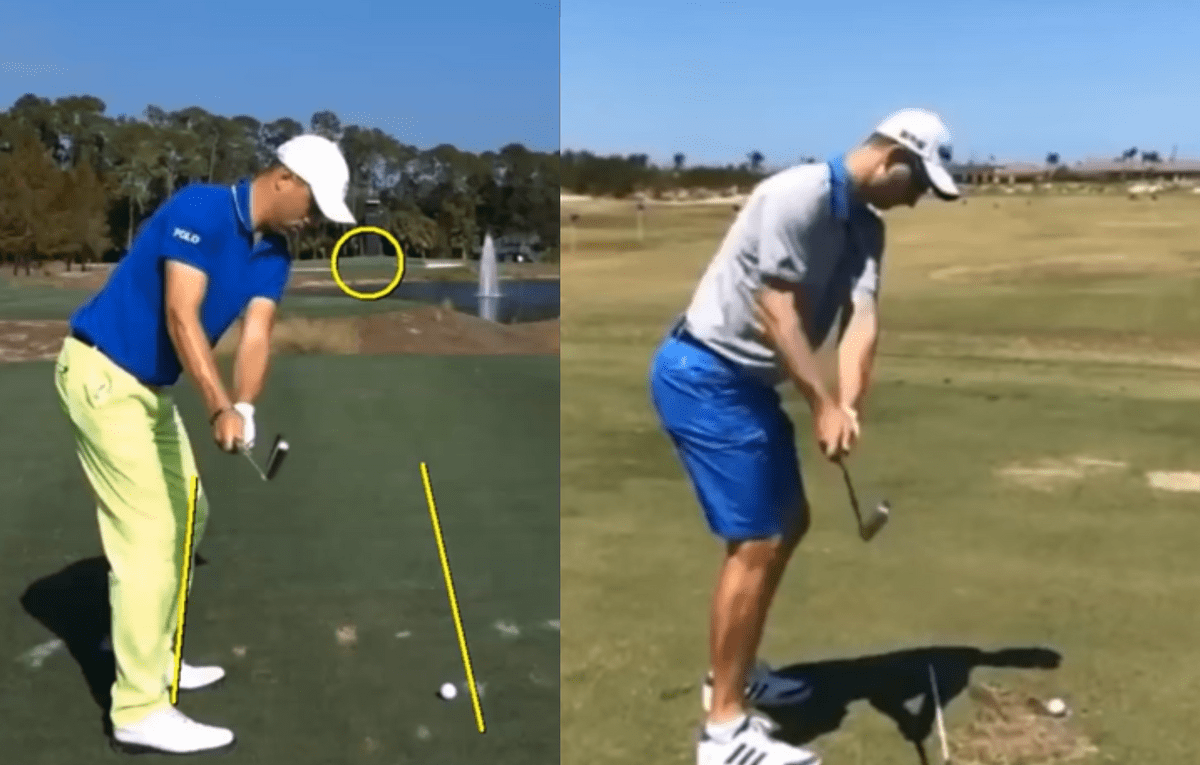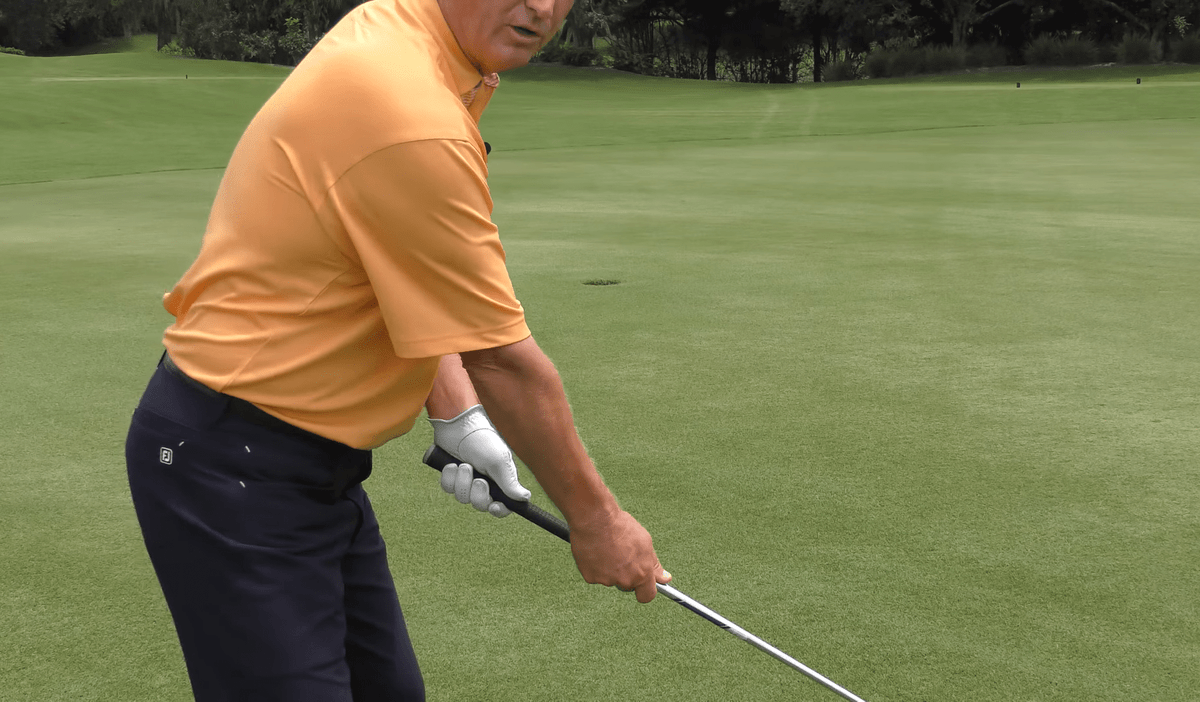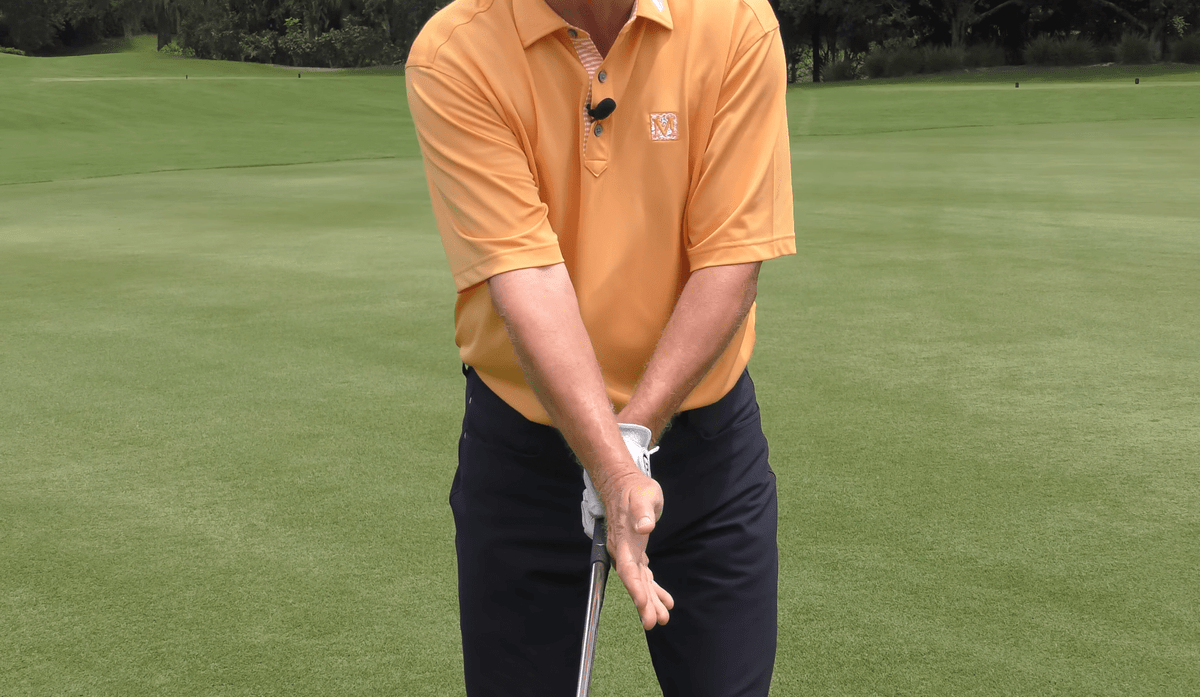How to Stop Hitting Behind The Golf Ball
I want to talk to you today about how to avoid hitting the ground behind the ball during your swing. It's a thing a lot of people battle with. There can be a number of circumstances involved in it, but let's focus on the two major elements and see if these give you a little bit of insight and help you progress in this area.
A lot of players keep their weight too far back. Now, don't get me wrong: we certainly don't advocate getting your head in front of the golf ball as you hit it (upon impact). I assure you: if you were to watch professional golfers hit irons and if you were to draw a line up from the ball, the ball is more in line with the right hip then it is would be with the left hip upon impact.
You really need to be on your left side (with your leading leg) when you make an impact with the ball. That is such an important thing in terms of heading the ground further over to the left.The tendency to straighten the wrist too early. What that does is it widens the swing arch, and the clubface prematurely reaches the ground before hitting the ball. If your right wrist is bent, the club would never actually reach the ground. That narrows the circumference of my swing.
Any combination you can get where your weight is further to the left (forward), with your head stationary and centered and your wrist are more cocked later in the downswing, this will going to give you a higher clearance from the ground and make you hit the ground slightly more forward of the ball.
Here is a simple drill that might get you started and help you out so that you stop hitting the behind the golf ball:
Line up a few golf balls in an area where you can practice and pretend the line extends a little bit. Use something like an 8 Iron. You'll just be making small swings. Go ahead and pre-set your hips and your weight to the left (forward). Keep your head at about center and feel most of your weight to the left. Practice releasing your wrist so that the club goes down on the front side of the ball. I say that because I don't think it's that effective to just try to hold your wrist angle. I think you want to time your release, or the snap of the wrist, in a different place. I find that most people have more success with that.
Remember, keep your weight forward and practice hitting the ground more over to the left. When you've gotten a little feel for that, just set up to the golf ball with your weight forward and hit some shots on a small scale. You should be able to see that you're hitting the ground just barely in front of the ball. This is critical for good iron play. I hope this drill gets you started.
Golf Backswing Drill For Better Takeaway
Our next subject is a golf backswing drill for a better takeaway. Bear in mind there are two things you're trying to accomplish here:
The sequence, how everything flows together.
The swing plane, it gets you started on the swing path.
I'll show you some ideas and a drill for both as we go along.
Let's talk a little bit about the takeaway. I believe the first thing that we want to get right here is: we want to get everything moving together. What I mean by that is you want to get the core of the body, the arms, and the club, all working together. Try not to be stiff. You don't need to be rigid or wooden. I think that there are two things that are really important:
The club should always be reacting to the body throughout your swing. Most of the time when people snatch the club back, the first instinct that they have is to whip the club down, so it gets you out of sync.
I think you'll find that when everything moves away together it's just much more repeatable.
Let’s have a look at two of the finest players in the game and they’re both named Justin: Justin Thomas on the left, and Justin Rose on the right. We're going to look at, in terms of the plane here, what are acceptable corridors ( that's the way Jim McLean describes it)? The acceptable Corridor for the take away is pretty much straight back from the ball (between the body and the golfer).

Let's have a look at Justin Rose (right). You can see that his positioning is extremely similar to Justin Thomas’. If you get your club behind your body or out beyond the golf ball, it's possible to hit, but that would be a pretty complex way to play. It would also be extremely difficult to repeat. Try and keep it simple.
Being a golf coach, I watch a lot of people hit golf balls. When I watch people hit the thing that they usually do is they tend to snatch the clubhead back. They get too much break in that back wrist, and that's how they get started, which is bad. I'm going to teach you a drill that really helps my students.
Go out to a golf course on a slow day, a practice course or a driving range to practice this drill. You’re going to set up normally, but you're not going to hit a ball with his drill. What you're going to do is you’re going to take a normal grip on your front hand but then use your following and hold the club shaft on the metal bit under the club handle. I call this a split grip.

The club head should be about five or six inches off the ground. Practice your backstroke going just a foot or two off the ball (or where the ball would be). What's going to happen is you're going to be aware of yourself if you break that angle (the corridor). Practicing the beginning of your backswing with a split hand grip is a beautiful way to rehearse what it should feel like to keep your club face on target.
Once you've done that a couple of times simply slide your hand back onto the handle and take a normal swing. See if you can get the same feel with your regular swing as you did with your practice swing.
A variation of that drill is to hold the club by the handle with your front hand (where you would normally), and then take your trailing hand and put it over your front hand in front of the club. The back of your hand should be resting on the club handle. Your arms should now be crossed, with your back hand opened up, palm facing toward the flag.

Just practice moving the club back and forth this way. You'll get a sense of your back hand aiming more forward towards the target. And again, you can really sense your plane when you do that, and that it is somewhat difficult to do. This is because you don't have the trailing hand on the club to snatch the handle up.
Let me show you another drill that I use with my students. The reason I'm putting this drill at the end of this section is that I think that when everything's moving in a good sequence, as we discussed at the beginning of the video, this drill becomes much easier.
Here's the drill: put something on the target line, such as a towel, a couple feet in from of you to use as a visual guide. You can use a golf ball for this drill. If you're standing at the ball golf and you take a few imaginary swings while you say to yourself, “if I had to go over the towel, or hit the towel, where would the plane of your backswing go?” Invariably, your backswing would be within that corridor. I have yet to see a person look at the towel, or target, and then snatch the club back or take it to far forward. Naturally, in the practice swing, people stay right in the corridor where they should be.
Stage two of the drill is where this gets interesting because it demonstrates how fixated on the ball people become. A lot of people get fretful over solid contact and that’s their mess up. So, take it 8 or 9 iron and then just hit the golf ball 30 or 35 yards with no concern for contact, while looking at the towel instead of the ball. If you don't hit the ball well, no big deal. Just get set up, look at the towel, and chip the ball from there without looking at the golf ball.
You'd be surprised how difficult that is for some people to do. People are so conditioned to fixate on the golf ball that they can't even trust themselves, even if there's no consequence for bad contact, to look over at the towel. Within a minute or so, however, you can get over this natural inclination. Now, look away from the towel so you can see both it and the golf ball, in your peripheral vision and chip a few more. Just compare some notes with yourself and think to yourself, “where do I go with the club during my backswing when I'm looking at the towel? Is it different when I look at the golf ball?” This is a great exercise because if you've got a good sequence of motion coupled with a little bit of target awareness, you will get significantly better within that corridor.
I hope that these golf backswing drills for a better take away are helpful to you. Continue to work on some of those ideas and if you do the drills I'm confident you will have some success.
Golf Pre-Shot Routine: Tips for grip, alignment, and posture
Here we're going to talk about something that I've had a lot of requests for (this topic is really important in golf): the pre-shot routine.
The pre-shot routine is a very, very important aspect of golf. Let me just say, they come in all shapes and sizes. We will touch on a few different things, and at the end of the day you've got to customize something that works for you, but I believe there are a few principles that you have to get done well to succeed. These principles are grip, alignment, and posture. Getting those principles in order can really help you up your golf game consistently. Once you get these principles down, you can customize it to fit your needs and playing style.
There is quite a bit that goes into getting ready to hit a shot, also known as the pre-shot routine. Those factors can include: deciding upon which shot to hit, how the lie affects the shot, how you are breathing, the calming of the mind, getting settling in, getting yourself in the right place to perform well, and more. But here in this section, we're going to confine ourselves to more of the physical aspect of what are the things you have to do as you're getting ready to hit a shot.
The first thing I want to touch on is the grip. I'm not going to get into that in any great detail because this is not a grip lesson. But, I would certainly advise that you take your grip to the side of your body with your lead hand (which is your left hand if you’re a right-handed golfer). There's a couple of reasons that this helps.
When your hand hangs at the side of your body, it hangs straight down. If you were to bend forward and hang your arm in front of you, it would tend to turn the palm inward. So, I always think it's less complex for alignment to have the hand straight on to the club handle, and to approach this with your hand at your side.
If you can avoid the temptation to look over your shoulder and see what's going on with your hand, your hand will relax. When it's relaxed it forms a beautiful contour- a place for the club to just rest. Don't grab the club at all until it's resting down in that contour of the fingers, at the base of the fingers, then simply apply a little bit of pressure and squeeze down on the handle.
Once that left hand is on there and is comfortably grabbing the handle of the club that is when I bring the club up and put my right hand on it. You'll see that same technique happen a lot on TV if you're watching professional golfers. You’ll see them looking out to see the target, and then you'll see a lot of them take the grip like that (not all of them, but it's pretty common).
Next comes what I believe is a fundamental principle of the pre-shot routine,and that's what happens when you step into the ball. The principle is this: line the club up to the shot/target, and then line yourself up to the club, not the target.
How many times have you seen a golfer line up, directly look down at their feet and shoulders, then at the driver, and then pull their head up and look directly at the flag or target? Do you see that often? Never do that! It is a terrible way to set up and it actually doesn't work. What you should be doing is actually lining yourself up to be aimed, not directly at the target, but rather aimed parallel or left of the target.
Here's what you want to do, and is literally what all the top players do. Line the golf club up, and then simply stand in front of the golf club. Easy. Don't line yourself up, other than to face the golf club. When you do it I would insistent upon the fact that you should step in with the back foot first. This is the trailing foot. You do this because it gives you a better perspective of the shot as a whole. Step in with the back foot first, then place the club where it needs to go, and then once you're happy with that you can add in your front foot and adjust your stance to be directly in front of the golf club. It's very easy to practice this at home, just picture a club standing in front of you and then just walk up to it. That's literally as much as you need to do to line up to the club. Make sure you do it that way, and you'll have a lot more success. When you overthink your approach, it will mess you up.
Before we look at what I think is the other really major fundamental component to a pre-shot routine, let's say one other thing. You've got your grip with your leading hand, you've put your trailing hand on the club, and you’ve stepped in with that trailing foot. When you step in with your trailing foot, try to step in a little bit behind the ball. The more you step in behind the ball (I'm only suggesting a little bit, maybe a few inches), the better your perspective of the target line will be, and it will be easier to get the club in line. You do not want to get in front of the ball even by a little bit and try to line up something that's behind your eyes or club. So just remember to set up your back foot slightly behind that ball.
One final principle that I think is foundational is: when you go ahead and set the clubhead on the ground, that's when you should be taking good posture. You could take the club and put it on the ground in any one of a lot of ways, but don't do that. Stand up nice and tall with the good grip we discussed and be sure there's a little bit of angle with the club shaft so the club doesn't reach the ground. It should be a foot so off the ground. Then, tilt forward at the hips with good posture and place the clubhead on the ground by the ball. Watch on TV: when the good players do this, the club does not go directly to the ground without the proper hip tilt. That's how they place it on the ground. That is the routine and that keeps you in good posture. You may have to practice doing this a little bit to get comfortable, but it's not super difficult. It simply takes a little bit of practice to get comfortable at it.
Avoid the terrible pitfall of just sticking the club on the ground and then trying to fight your way into good posture. Check out any professional playing on TV and you will see that when they step in they take their posture beautifully in order to put the club down, not visa versa. It's a much easier way to go about it.
I hope that helps you with your pre-shot routine I know there are a few different ways to go about it, but if you adhere to some of these principles and develop a little bit, you will have success.
If you want to learn more about golf, and get some private lessons, check out http://tinyurl.com/george-gankas. There you will find a huge amount of awesome golf tips and drills.